Microsoft Surface 2 Review
by Anand Lal Shimpi on October 21, 2013 12:00 AM ESTSoC, CPU & Performance
At the heart of Microsoft’s Surface 2 is a quad-core NVIDIA Tegra 4 SoC. That’s four usable ARM Cortex A15 cores running at up to 1.7GHz (1.9GHz with only a single core active), behind a shared 2MB L2 cache. You also get NVIDIA’s most powerful ultra mobile GPU to-date, a 72-core implementation of its ultra low power GeForce architecture. The combination of the two gives Microsoft a much better platform than the original Surface RT device.
The difference is immediately apparent. While Surface RT felt slow, Surface 2 feels fast enough for most light workloads. Typing in Word now typically consumes < 20% of all available cores/CPU cycles, compared to 20 – 40% on last year’s Tegra 3 based model. I can still get CPU utilization as high as 50% by pounding on as many keys as fast as possible, but that’s the exception not the rule.
If you remember back to my first Surface RT review I talked about how I could sometimes type quicker than the system would be able to process and display my text. I’m happy to say that’s no longer an issue, although I’m not sure how much of it is software vs. hardware improvements. Needless to say that for general Office work, Surface 2 is a much better device than its predecessor.
Application launch times are also a bit better compared to Surface RT at launch. Some apps still take longer to initialize than their equivalents under Android or iOS, but the improvements over the past year have been significant. Applications that used to take 5 – 7 seconds to launch now take 2 – 4 seconds. That’s compared to the < 2 seconds for most of the core apps on iOS, but it’s movement in the right direction at least.
On the CPU side we don’t have a ton of great performance tests to let us compare platforms (not yet at least), but we do have our standard suite of js benchmarks. Since we’re dealing with Windows RT, the only browser option is Internet Explorer 11 – which is both a blessing and a curse depending on what benchmark you’re looking at.
I’ll start with SunSpider since that appears to be the best case for IE11. Here we see just how much software can influence the overall performance of these browser based benchmarks.
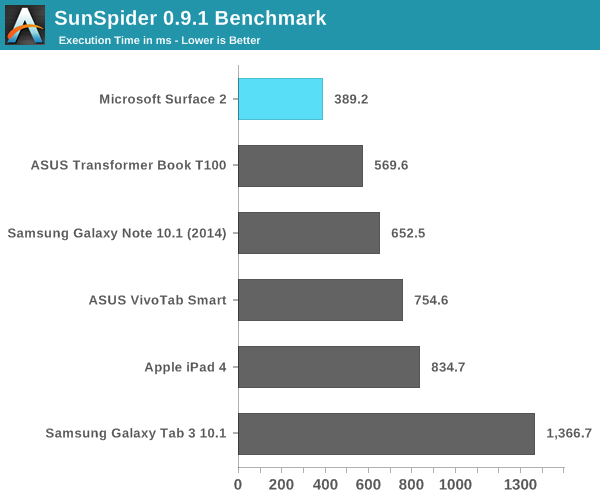
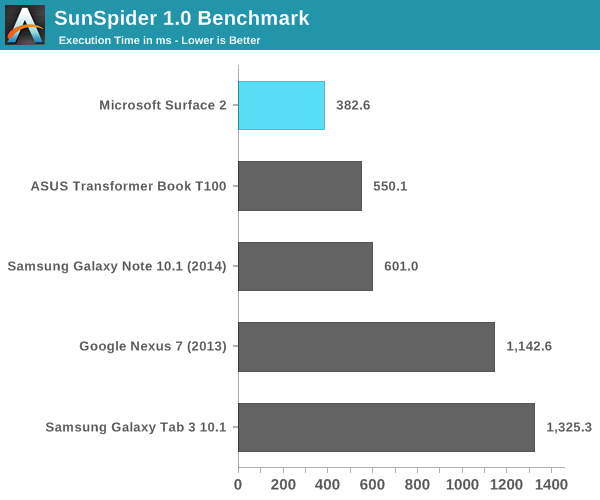
Tegra 4 running IE11 posts a better SunSpider score than even the A7 based iPhone 5s. Looking at the rest of the tests it’s very clear that SunSpider was an optimization target for Microsoft, as we don’t see this sort of performance leadership repeated anywhere else.
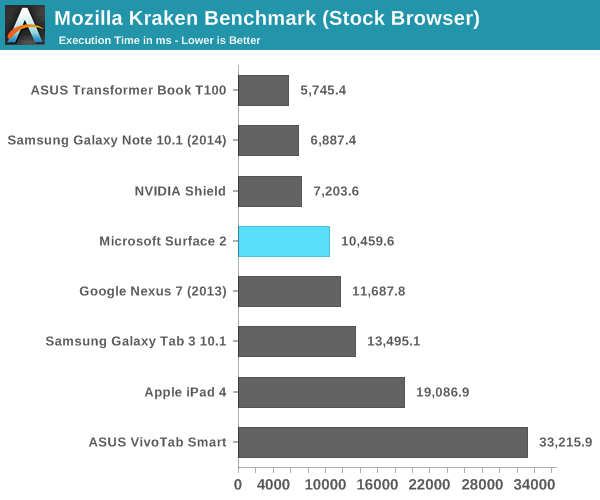
The Kraken results look decent but clearly behind high-end Android devices running Chrome. This is a huge improvement over where Microsoft was last year with Surface RT. Surface 2 can now complete the Kraken test in roughly 1/5 of the time it took Surface 1/RT to do the same work at launch. Obviously we’re seeing the benefits of IE11 in addition to Windows RT 8.1 being better optimized for ARM architectures (as well as a faster SoC), but the new tablet is just significantly faster than its predecessor.

Browsermark 2.0 gives us a good idea of where Surface 2 falls in terms of overall browsing performance. In general we’re dealing with a platform that is roughly comparable in performance to modern Android devices, but it’s not pushing the limits of performance in any way.

Google’s Octane test is obviously best optimized for Chrome, and here we see solid performance although clearly behind the fastest Android and Bay Trail devices.
GPU Performance
All of the Windows RT devices that launched last year had pretty terrible GPU performance. It didn’t matter if you had something with NVIDIA or Qualcomm inside, GPU performance wasn’t great at all. Even Intel’s competing Clover Trail solution was a huge let down on the GPU front. Clover Trail was so bad that I even noticed differences in animation frame rate between the Atom Z2560 and Qualcomm’s APQ8060A running Windows RT.
Tegra 4’s GPU on the other hand seems well suited for the task at hand. I doubt many users will be playing 3D games on Surface 2, but GPU performance is improved substantially over its predecessor. In the grand scheme of things we’re talking about roughly iPad 4 class GPU performance, all while driving a lower resolution screen.
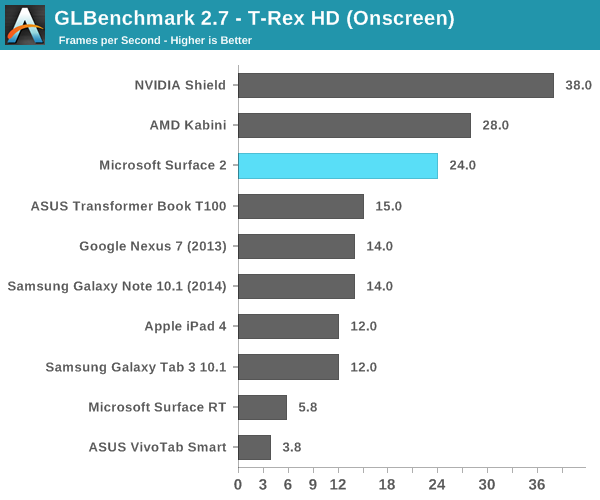
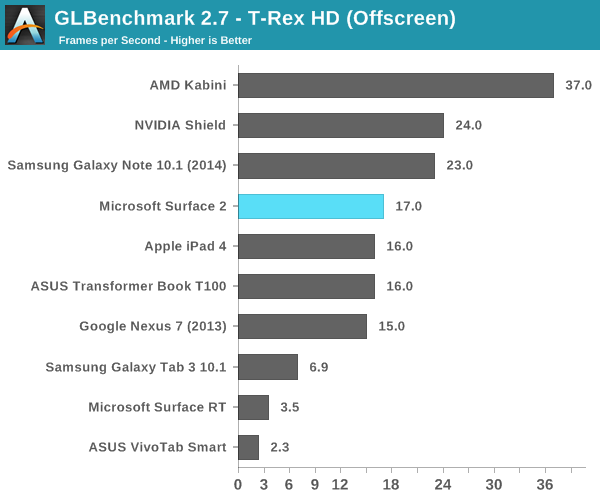
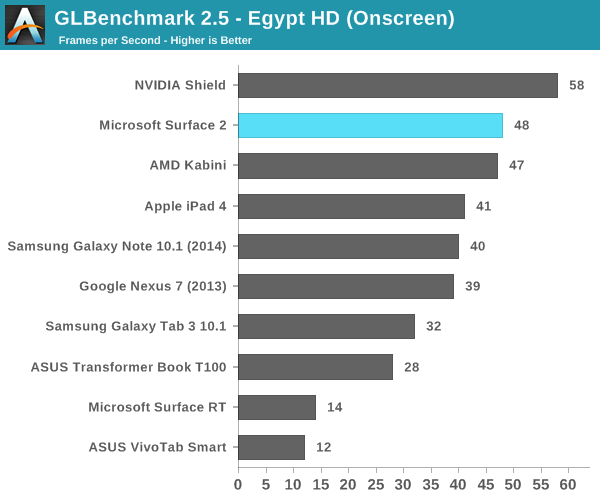
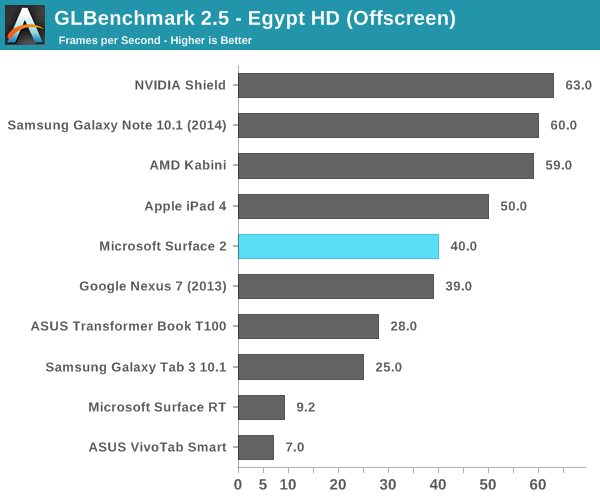



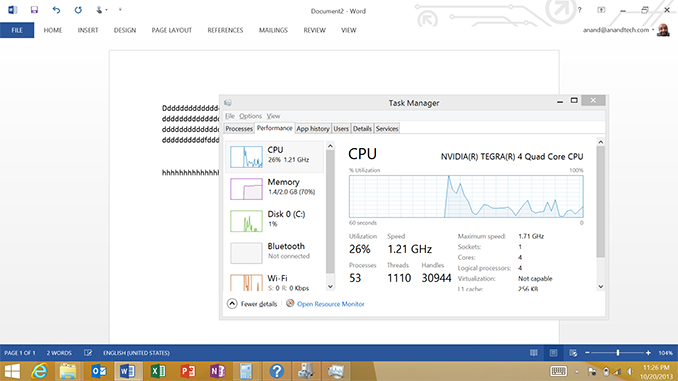








139 Comments
View All Comments
purerice - Monday, October 21, 2013 - link
Now that you put it that way, you're right. Workers need to separate their private lives and their work lives. That would not only improve their performance at work but also their performance at home.Mopar63 - Monday, October 21, 2013 - link
I am not sure what issue you are having. I log into Skydrive software just fine and do not have to keep logging in, the same applies to my other services through Explorer. The issue you seem to be facing is one of setup. If the domain account is not set for internet access then you can use your MS web based account just fine unless your domain is designed to block it. This is not a limitation of Windows but of domain setup.Wolfpup - Thursday, October 31, 2013 - link
Windows 8 allowed you to log in to Skydrive, and it was even integrated in Explorer. Windows 8.1 doesn't. Skydrive is unusable. The only way to use it would be to use a Microsoft account on your local machine, instead of your own account, which of course isn't something anyone should do.RannXeroxx - Sunday, November 24, 2013 - link
A domain has not connection with Microsoft unless you connect the two via federated services such as Office 365. Also SkyDrive and SkyDrive Pro as separate things as the Pro version is for corporate usage. You system administrator can disable the ability for you to connect your company own device to the consumer version of SkyDrive while linking your computer to the corporate version. Also in the corporate world, AD identity management is handled with another backend system.It just sounds like your company simply has no policies or processes to manage Windows 8(.1) devices in their environment which is not surprising since most have not even fully integrated Windows 7 with all of its corporate connectivity into their environment and treat it like its XP.
Theard - Wednesday, October 30, 2013 - link
Ethan. I can see what your saying... Joe`s c0mment is unimaginable... last monday I got a great new Saab 99 Turbo sincee geting a check for $7753 this-last/month and-just over, 10/k last munth. without a doubt its the most rewarding I have ever done. I started this three months/ago and pretty much immediately was bringing in at least $74, per hour. Learn More ... jobs23.comOoklaTheMok - Monday, October 21, 2013 - link
You do not have to switch to logging into the computer using a Microsoft Account, that would be ridiculous. You can do one of the following, you can connect a Microsoft Account to your local login or if you don't want to connect a Microsoft Account, you can use a Microsoft Account only with SkyDrive.Wolfpup - Thursday, October 31, 2013 - link
No, you can't do either of those things. The wording SOUNDS like it's going to let you associate a Microsoft account with your Windows account, but at the last minute wants to switch you over.And you USED to be able to log in independently in Windows 8, but that's now gone in 8.1. They broke Skydrive support with 8.1
Braumin - Monday, October 21, 2013 - link
You don't have to switch you can connect your domain account to your MS account in the settings page.noeldillabough - Monday, October 21, 2013 - link
I haven't figured out how to do that yet; in Windows 8 you simply clicked on skydrive and entered your account info and it worked. In 8.1 it only has the "switch" option. Which settings page? I must have missed it.noeldillabough - Monday, October 21, 2013 - link
Just checked on the "Account" part of the Win8.1 settings, and it only has "Connect to a Microsoft Account" available. I tried it to see if it would keep the local account settings but no I actually have to log in to the computer using the Microsoft account. This of course won't fly in the corporate world so I put it back (that was painful too since the Microsoft account and the domain account had the same name)